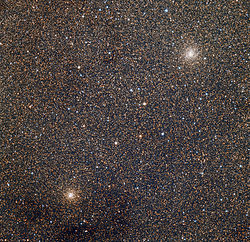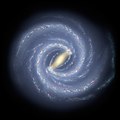Baade's Window


Baade's Window is an area of the sky with relatively low amounts of interstellar dust along the line of sight from Earth. This area is considered an observational "window" as the normally obscured Galactic Center of the Milky Way is visible in this direction. This makes the apparent Large Sagittarius Star Cloud visible.
It is named for astronomer Walter Baade, who first recognized its significance. This area corresponds to one of the brightest visible patches of the Milky Way. It is centered at a galactic longitude (l) of 1.02° and a galactic latitude (b) of -3.92°,[1] which corresponds to a right ascension of 18h 03m 32.14s and a declination of -30d 02m 06.96s, in the direction of the constellation Sagittarius.[2][3]
History
Walter Baade observed the stars in this area in the mid-1940s using the 100-inch (2.5 m)
In 2006, the
Significance

Baade's Window is frequently used to study distant central
Baade's Window is the largest of the six areas through which central bulge stars are visible.[7]
Stars observed in Baade's Window can be called BW stars, similarly giant stars can be called BW giants.[8]
See also
References
- ISSN 0004-6361.
- ^ "NAME Baade Window". SIMBAD. Centre de données astronomiques de Strasbourg. Retrieved 2011-03-13.
- ^ "Your NED Search Results-Input: Galactic/Output: Equatorial J2000.0". ned.ipac.caltech.edu. Retrieved 2020-06-02.
- doi:10.1086/125835.
- ^
"SIMBAD Details on Acronym: SWEEPS". Centre de Données astronomiques de Strasbourg. Retrieved 2009-05-21.
- S2CID 11590782.
- S2CID 15619180.
- ISSN 0004-6256.

